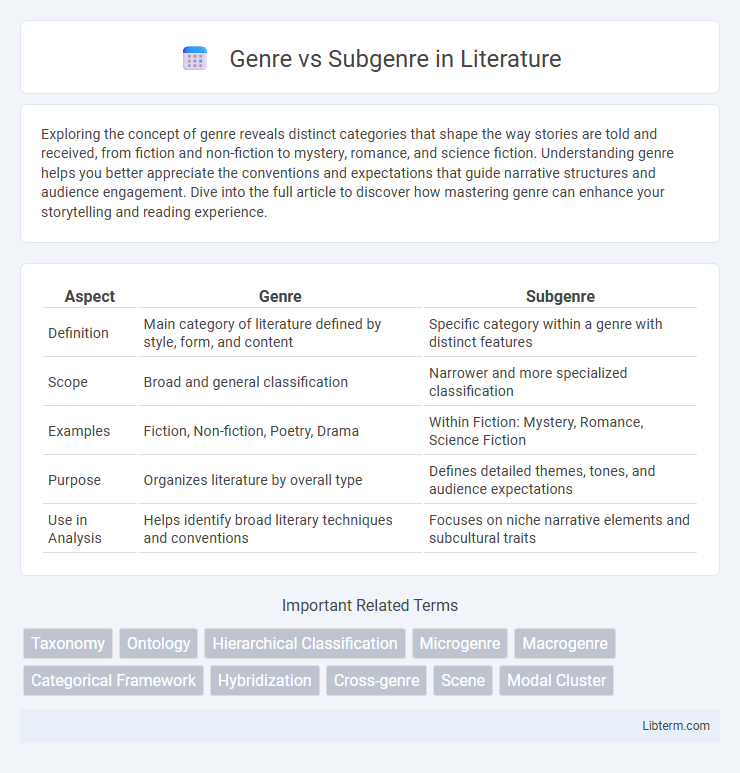Exploring the concept of genre reveals distinct categories that shape the way stories are told and received, from fiction and non-fiction to mystery, romance, and science fiction. Understanding genre helps you better appreciate the conventions and expectations that guide narrative structures and audience engagement. Dive into the full article to discover how mastering genre can enhance your storytelling and reading experience.
Table of Comparison
| Aspect | Genre | Subgenre |
|---|---|---|
| Definition | Main category of literature defined by style, form, and content | Specific category within a genre with distinct features |
| Scope | Broad and general classification | Narrower and more specialized classification |
| Examples | Fiction, Non-fiction, Poetry, Drama | Within Fiction: Mystery, Romance, Science Fiction |
| Purpose | Organizes literature by overall type | Defines detailed themes, tones, and audience expectations |
| Use in Analysis | Helps identify broad literary techniques and conventions | Focuses on niche narrative elements and subcultural traits |
Understanding Genre: A Fundamental Overview
Genre classifies creative works into broad categories based on shared themes, styles, or forms, helping audiences quickly identify the nature of the content. Subgenre further refines these categories by incorporating specific elements, settings, or narrative techniques that distinguish a niche within the main genre. Understanding the distinction between genre and subgenre is essential for creators and consumers to accurately describe, market, and engage with various types of media.
Defining Subgenre: Nuances Within Categories
A subgenre refines the broader genre by highlighting specific thematic elements, narrative styles, or settings that distinguish it within the primary category. For example, within the mystery genre, subgenres like cozy mysteries emphasize amateur sleuths and lighthearted tones, while hardboiled mysteries focus on gritty, realistic crime scenarios. This nuanced classification helps readers and creators better understand and target specific audience preferences.
Key Differences Between Genre and Subgenre
Genre classifies creative works into broad categories based on shared characteristics, such as fiction, non-fiction, or fantasy. Subgenre further divides these broad categories into more specific types, like urban fantasy within fantasy or cyberpunk within science fiction. The key difference lies in the level of specificity, with genres offering a general classification and subgenres providing detailed distinctions that cater to niche audiences.
Historical Evolution of Genres and Subgenres
Genres originated as broad categories in literature and art, serving to organize works based on shared stylistic and thematic elements, while subgenres emerged as more specialized classifications that reflect nuanced distinctions within these categories. The historical evolution of genres and subgenres demonstrates a dynamic process influenced by cultural shifts, technological advancements, and audience preferences, leading to the continuous diversification of artistic expressions. Notable examples include the development of the novel genre into subgenres such as historical fiction, science fiction, and romance, each adapting to specific narrative conventions and reader expectations over time.
Popular Examples of Major Genres
Major genres such as fiction, non-fiction, fantasy, mystery, and romance define broad categories of storytelling, each encompassing diverse themes and narrative styles. Popular subgenres like urban fantasy, historical romance, cozy mystery, and biographical non-fiction provide more specific frameworks, enriching the reader's experience with targeted elements and settings. Understanding distinctions between genre and subgenre helps readers and creators navigate the literary landscape more effectively.
Unpacking the Most Common Subgenres
Genres categorize broad types of artistic works like literature, film, and music, while subgenres offer more specific classifications that highlight unique stylistic or thematic elements. Common subgenres include horror's slasher and supernatural categories, fantasy's dark and urban varieties, and romance's historical and contemporary styles. Understanding these subgenres helps creators and audiences navigate nuanced preferences and expectations within the larger genre framework.
The Role of Genre in Audience Expectations
Genre establishes a framework of conventions and themes that shape audience expectations, guiding their anticipation of plot structure, character types, and emotional tone. Subgenres refine these expectations by adding specific elements or variations within the broader genre, such as horror-comedy or science fiction thriller, which tailor the experience more precisely to audience preferences. Understanding the role of genre helps creators deliver content that resonates with their target audience and meets the anticipated narrative patterns.
How Subgenres Influence Storytelling Techniques
Subgenres refine the broader category of a genre by introducing specific thematic elements and narrative conventions, which directly shape storytelling techniques. For example, in the horror genre, the subgenre of psychological horror emphasizes internal conflict and suspense, often using unreliable narrators and fragmented timelines to build tension. These tailored approaches enhance immersion and emotional impact, illustrating how subgenres drive innovation within established genres.
Genre Blending: When Categories Overlap
Genre blending occurs when elements from multiple genres combine, creating rich and unique narratives that challenge traditional classifications. This overlap can blur the lines between primary genres, such as fantasy and mystery, enriching storytelling by incorporating diverse thematic and stylistic features. By merging conventions from various subgenres, creators produce innovative works that appeal to a broader audience and reshape genre boundaries.
The Importance of Genre and Subgenre in Modern Media
Genre and subgenre classifications play a critical role in modern media by guiding audience expectations and enhancing content discoverability. These categories enable creators to target specific market segments and tailor storytelling techniques to meet diverse viewer preferences. Effective use of genre and subgenre improves algorithmic recommendations, driving engagement and increasing the commercial success of films, TV shows, video games, and literature.
Genre Infographic

 libterm.com
libterm.com